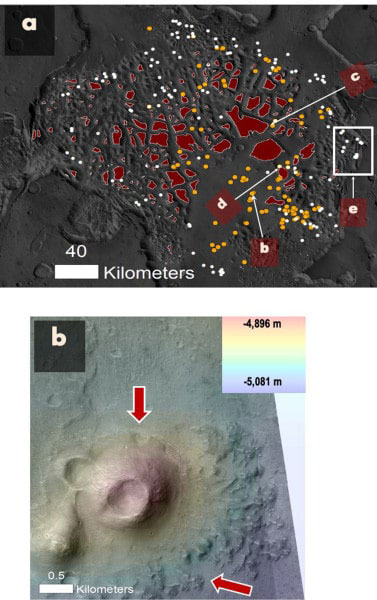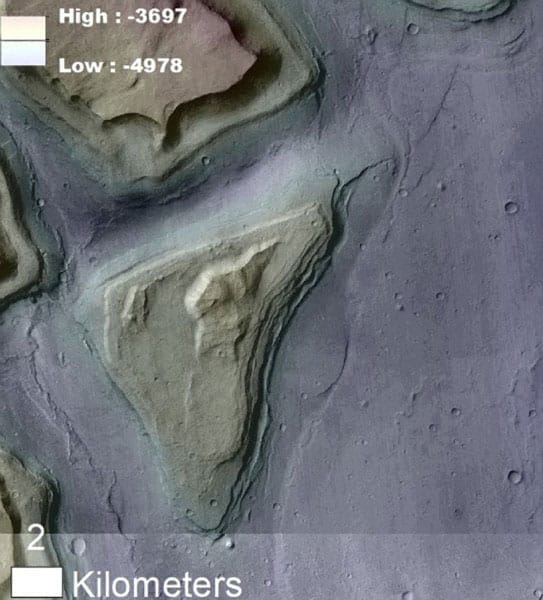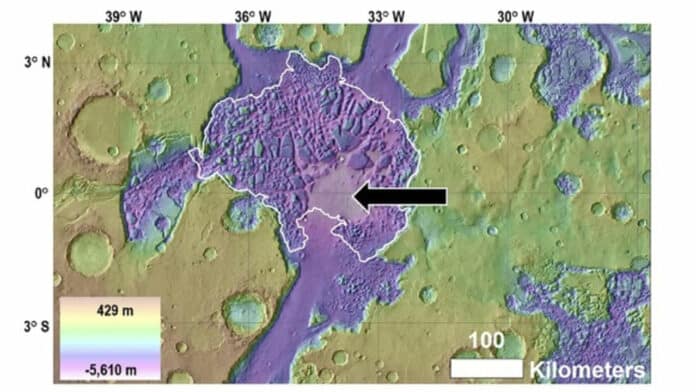Finding surface formations connected to previous habitability is crucial to the search for ancient Martian life. Stable subsurface aquifers survived for a very long time after Mars’ surface is thought to have transitioned to freezing conditions 3.7 Ga ago. Megafloods caused by their massive collapse occurred at 3.4 Ga, and the outflow channel excavation resulted in significant sediment erosion from the highlands. The northern lowlands are thought to have been thoroughly blanketed by these minerals.
A collaborative research led by Alexis Rodriguez of the Planetary Science Institute has made a significant discovery that reveals evidence of sedimentary plains produced by aquifer drainage within Martian collapse formations known as chaotic terrains.
Scientists mainly focused on a sedimentary unit within Hydraotes Chaos, believed to be the remnants of a mud lake formed by discharges from gas-charged mudstone stratigraphy dating back nearly 4 billion years ago. At that time, the Mar’s surface was interpreted to be habitable.
These sediments may contain traces of previous or present-day life. It’s vital to remember that Mars’s subsurface may have been habitable for the entirety of Earth’s life history.

Large flood routes extending thousands of kilometers into the planet’s northern plains have been discovered due to considerable research on the draining of the Martian aquifer. Large areas of the northern lowlands are covered in sediment from the aquifers released into the subsurface due to the tremendous erosion caused by these canals. The research on the makeup of the Martian aquifers is made extremely difficult by this diverse landscape.
Going into the northern plains for sampling could be risky since it could be challenging to tell which elements came from the aquifers and which were eroded and transferred during channel formation. The plains in Hydraotes Chaos provide a distinctive look into the components of an old aquifer.
Rodriguez said, “These plains, which we think formed from mud extruding into a basin directly above their source aquifer, provide a more targeted exploration opportunity. Unlike vast flood channels with complex erosion patterns, this finding simplifies the examination of Martian aquifers, reducing the risk of overland sedimentary acquisition, and opens a new window into Mars’ geological past.”
PSI scientist Bryan Travis said, “Our numerical models reveal a fascinating story. The lake’s source aquifer likely originated from phase segregation within the mudstone, forming vast water-filled chambers several kilometers wide and hundreds of meters deep. This process was likely triggered by intrusive igneous activity. Moreover, the observed segmented subsidence across the chaotic terrain suggests an interconnected network of chambers, depicting stable water-filled giant caverns, some reaching kilometers in widths and lengths, way larger than any known Earth counterparts.”

Rodriguez said, “Initially, biomolecules could have been dispersed throughout the volume of large-groundwater filled cavities. As the water was released to the surface and ponded, the water went away, leaving behind lags of sediments and potentially high concentrations of biomolecules.”
As a result, the leftovers from this ancient mud lake may offer unheard-before access to aquifer materials rich in biomolecules that have lain dormant beneath Mars’ surface for most of its life.
Co-author Mary Beth Wilhelm of NASA Ames Research Center said, “NASA Ames is considering the plains as a possible landing site for a mission to search for evidence of biomarkers, specifically lipids. These extremely resistant biomolecules could have endured billions of years on Mars.”
The study area also has numerous mud volcanoes and possible diapirs, which offer further views into subterranean, potentially habitation rocks. The likelihood of finding a biosignature is greatly increased by the ability of a tiny rover to sample these components and the mud lake sediments within short distances.
Daniel C. Berman said, “Our crater counts indicate that the plains are relatively recent, returning an age of 1 billion years. This age is good news for our search for life. This age is way younger than most aquifer releases on Mars, dating back to approximately 3.4 billion years ago. So, the materials spent a huge amount of time in the subsurface.”
Journal Reference:
- Rodriguez, J.A.P., Wilhelm, M.B., Travis, B. et al. Exploring the evidence of Middle Amazonian aquifer sedimentary outburst residues in a Martian chaotic terrain. Sci Rep 13, 17524 (2023). DOI: 10.1038/s41598-023-39060-2
